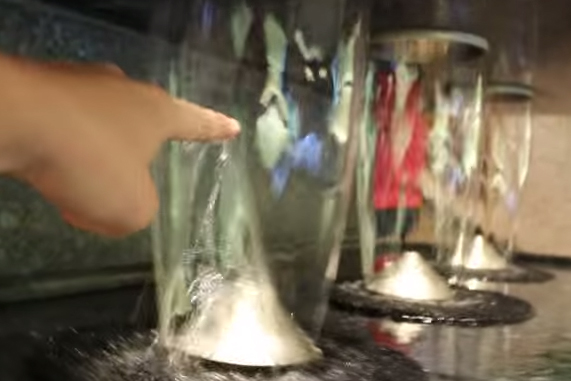fountain design
David L'Heureux For much of human history, those with power and wealth have been willing to put both on display in the places they choose to reside. There are palaces and great houses all over the planet, each one testifying to the grandeur of its owner and the talents of the architects and designers brought in to turn grand visions into actual structures and garden spaces. Often, those commissioning these conspicuous projects were members of
The process of selling off back issues of WaterShapes has been a sentimental journey for me, and I know it's going to become even more so when the recycling truck shows up on June 1 to clear away all of the unclaimed copies: I love those printed relics with all my heart, and I hope I'll be packing lots of them up in the next few days and
No matter where you turn these days, you'll find watershaping experts preaching the gospel of balanced hydraulics. In class after class, text after text, they all say that if you do exactly the same thing on one side of a tee as you do on the other, you will get the same flow on both side of that tee. If, for example, two main drains are connected to a single tee with pipes of the same length and diameter and the same fittings, those drains will both draw equal amounts of
Water in the open basins that commonly surround fountain jets or nozzles is never tranquil while these systems are in operation. It will slosh around in response to the upward thrust of those jets or nozzles as well as the splashing the rising water makes as it drops back into the basin. If the circumstances are right, this disruptive splashing will produce waves in a distinct, consistent pattern. By exploiting these waves, it's possible to produce an effect I find
THE ESSENTIAL E-NEWSLETTER FOR WATERSHAPE DESIGNERS, ENGINEERS AND BUILDERS February 4, 2015 www.watershapes.com CASE STUDIES…
When I prepare my Travelogues, I always spend some time, usually midway through the process, looking at what's available on the Internet to support the basic observations I'm getting ready to offer. Often, for example, I'll confirm information I already have about designers or engineers or installers (and their clients), touching all the bases to get the details right. As important, I'm on the lookout for
In recent years, cities across the United States have found that restoring their old train stations is a great way to attract people and commerce to downtown districts that have seen better days. These revitalization projects have picked up the pace in cities from Washington, D.C., to Los Angeles, and they seem to work best when old, original functions are preserved and mixed in with the new.That's precisely the direction that redevelopment of Denver's historic Union Station has taken: The classic, Beaux Arts-style building, which opened in 1914, lost almost all of the
I haven't called attention to many of what you might call "conventional" fountains in my Travelogues. You know what I mean: the standard sort of bowl fountains with modest flows, bronze sculptures and lots of patina. It's not that I haven't come across many that I like and admire during my travels; it's just that most of their stories seem a bit too similar.
In the case I'll discuss here, however, there's an odd tale of déjà vu to tell: Back in July of 1978, while I was in Rome, I sought out fountains just about wherever I walked around the city because it was so unbelievably hot. Even small fountains were islands of coolness under the intense Italian sun.
One of the fountains I encountered looked familiar when I crossed its path: The Fontana delle Tartarughe (seen above) wasn't s show-stopper by any means, but it was charming and cooling - and challenged me with the nagging sense that I'd seen it before.
Set where there had once been a fountainhead for the Roman aqueduct system, this one had been built in the 1580s as the collaboration of an architect, Giacomo della Porta, and a sculptor, Taddeo Landini. The creatures that lent the fountain its name were added about 80 years later during a restoration project; they were by either Gian Lorenzo Bernini (which would be exciting, as he was a truly great artist and architect) or by Andrea Sacchi, a renowned painter (but not anywhere close to Bernini's league).
My guidebook, long gone, doubtless told me all of this, and I'm certain the Bernini connection would've caught my eye. But what really grabbed me was the translation of tartarughe it offered: This was the "Fountain of the Tortoises" - and I had indeed seen it before, only the last time it had been in a small park on Nob Hill in San Francisco.
About four years before my visit to Rome, I'd spent a week in San Francisco, walking up and down hills and exploring everything I could reach on my happy 18-year-old feet. I'd been to Nob Hill and had walked through Huntington Park and had seen what turned out to be a reproduction (seen just above) of the Fontana delle Tartarughe that had graced the space since 1954.
It was all about the tortoises, both times. They looked a bit silly hanging out over the edge of the large fountain bowl, so when I saw them again in the same absurd posture in Rome years later, it triggered the memories and kicked up a curiosity that made me linger long enough that I checked my guidebook and saw that tartarughe translated to tortoise - and I knew in a flash where I'd see this before.
You can go to Rome to see the original, but to me the San Francisco version has almost as much going for it - other that 450 years of art history atop 2,000 years of Roman hydrological history, of course. Cool in either place, I'd say.
WaterShapes has been privileged to publish countless beautiful photographs through the years, and many of the best of them ended up on the printed magazine's cover.On a few occasions, however, great images weren't available for cover appearances. There were several possible reasons for this, but most often it had something to do with



















